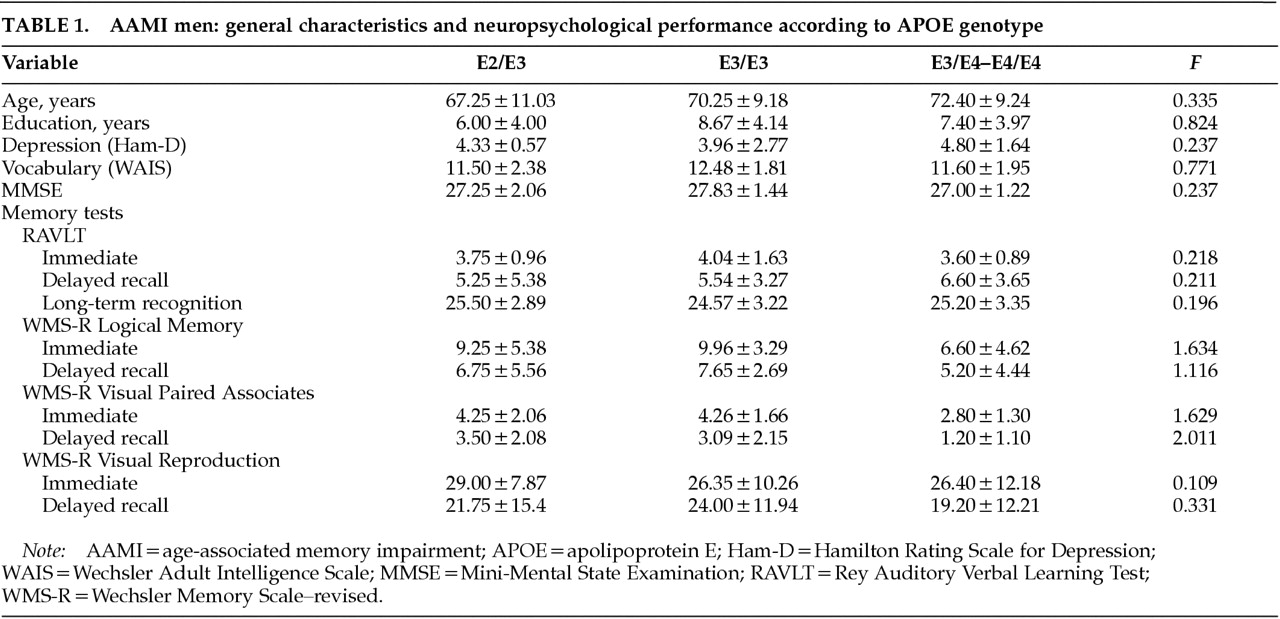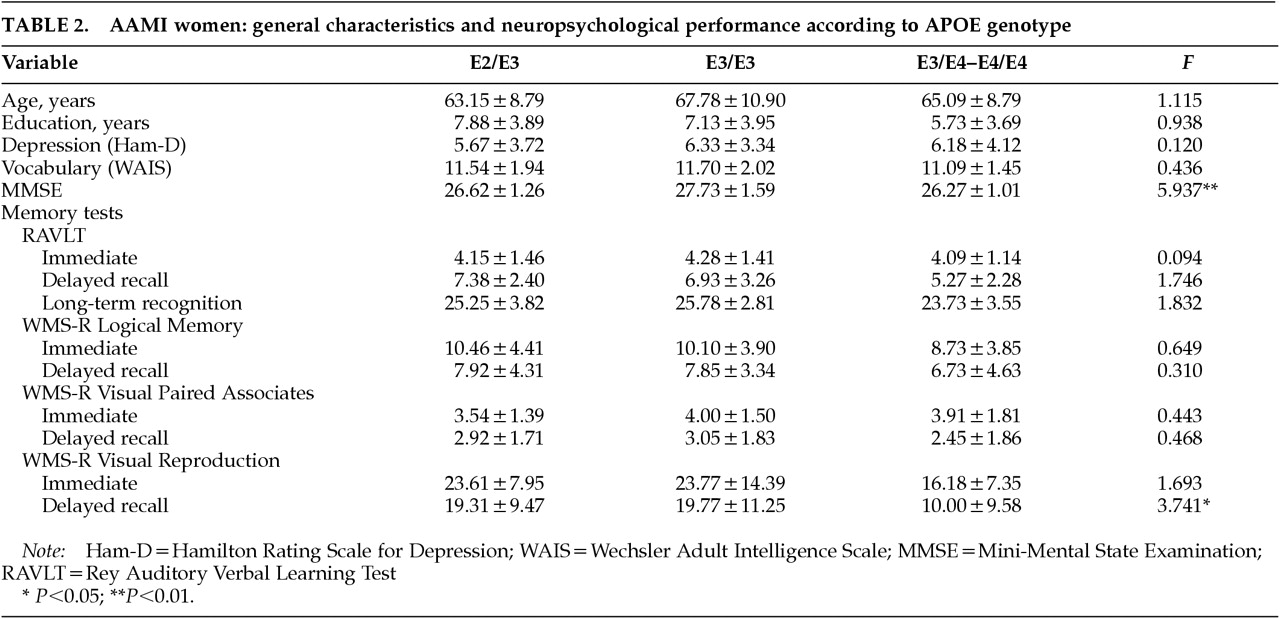The apolipoprotein E (APOE) E4 allele represents an established genetic risk factor for Alzheimer's disease (AD).
1 However, the effect of APOE genotype is not limited to this condition and also influences cognitive performance in the healthy elder population, in which those bearing the E4 allele present low cognitive performance, mainly in memory tests.
2 Moreover, several studies have suggested that the APOE genotype may affect the probability of developing AD for women to a greater extent than for men
3–5 and that the effect exerted by APOE genotype on cognitive performance in the general population is more pronounced in women than men.
6Age-associated memory impairment (AAMI) is a clinical entity described by a National Institute of Mental Health (NIMH) workgroup to define healthy elder subjects presenting subjective complains and objective impairments of memory.
7 Determining which variables are related to cognitive status of AAMI subjects is of potential interest because this category has been considered to represent a continuum between normal aging and dementia
8 and longitudinal studies have confirmed that a subgroup of individuals with AAMI represent high risk individuals for AD.
9 In a sample of 58 NIMH-AAMI subjects, we recently showed that the APOE status influenced the degree of memory impairment, those presenting the APOE E4 allele exhibiting worse measures of declarative and procedural memory tests.
10 Despite the above-described findings in the general population, no study has addressed a putative gender effect of APOE polymorphism on AAMI cognitive performance. The purpose of this study was to relate APOE genotypes to cognitive performance in a larger sample of AAMI subjects and to determine if the genetic variable differentially modulates cognitive status within each gender.
METHODS
AAMI subjects were recruited from different health centers and geriatric homes from the northeastern Iberian Peninsula (Barcelona, Catalunya). Subjects of 50 or more years of age consulting for progressive memory loss were administrated AAMI-NIMH inclusion and exclusion criteria.
7 Briefly, all subjects were healthy according to routine laboratory tests and medical examinations, were not mentally retarded (Wechsler Adult Intelligence Scale [WAIS] Vocabulary scaled scores of 9 or more), and not depressed (Hamilton Rating Scale for Depression, cutoff 12). In addition, subjects were found not to be demented (Mini-Mental State Examination [MMSE], cutoff 24) and to be within the clinically normal range according to age-corrected norms of an extensive neuropsychological battery that included assessments of language (Boston Naming Test, Token Test), gnosis (Luria's watches, Poppelreuter figures), praxis (Luria's premotor praxis, WAIS block design), and abstract reasoning (WAIS similarities). AAMI principal inclusion criteria required that all subjects score within 1 SD of established norms for young adults on measures of secondary memory on one or more of the following neuropsychological tests: Logical Memory, Visual Reproduction, Visual Paired Associates (Wechsler Memory Scale–Revised; WMS-R), and Rey Auditory Verbal Learning Test (RAVLT). Measures of immediate (first-trial sum in the case of RAVLT) and free delayed recall (after 30 minutes) were obtained from all tests, and a long-term recognition trial (30 minutes) of 30 items was obtained from RAVLT. One hundred unrelated individuals fulfilled NIMH-AAMI criteria and participated in the study. All subjects gave written informed consent. To determine the APOE genotypes, restriction endonuclease
HhaI (Boehringher-Mannheim 5 units) was used. The procedure is described elsewhere.
11 Two-tailed analysis of variance (ANOVA), Student's
t-tests, and chi-square tests were used for statistical purposes. DMS post hoc test values were considered when significant findings appeared in ANOVA. Statistical significance was considered to be attained at
P<0.05 level.
RESULTS
The number of cases for each genotype (E2/E2=0, E2/E4=3, E2/E3=17, E3/E3=64, E3/E4=13, E4/E4=3) and allele frequencies (E2=0.16, E3=0.79, E4=0.17) of APOE in the entire sample of 100 AAMI subjects were found to be in Hardy-Winberg equilibrium (χ2=6.95, df=5, P=0.22). For statistical comparisons, subjects were further divided into E2/E3 subjects (17 cases; no E2/E2 cases were observed) E3 homozygous (64 cases), and E4 carriers (16 cases, E3/E4 and E4/E4 genotypes). Individuals carrying the E2/E4 genotype (3 cases, 1 woman and 2 men) were excluded from the analyses because we intended to study separately the effects of E2 and E4 alleles and the group was too small to create a new category.
For the entire AAMI sample, there were no differences between APOE subgroups in age (F=1.436, df=2, P=0.243), years of formal education (F=0.854, df=2, P=0.429), depression scores (F=0.055, df=2, P=0.946), or general intellectual level inferred from WAIS Vocabulary scaled scores (F=1.26, df=2, P=0.329). The MMSE scores, however, differed among groups: APOE E3/E3 exhibited higher scores (mean±SD: 27.72±1.52) compared with E2 (26.76±1.44; post hoc P=0.013) and E4 (26.50±1.10; post hoc P=0.002). APOE E2 and E4 carriers did not differ in MMSE scores (post hoc P=0.6). Additionally, there were differences in long-term WMS-R Visual Reproduction (F=3.55, df=2, P=0.033), APOE E3/E3 presenting higher scores (21.34±11.60), APOE E2 having intermediate values (19.88±10.64), and E4 carriers showing the lowest performance (12.88±10.97). In this case the post hoc analyses revealed differences between APOE E3/E3 and APOE E4 groups (P=0.009).
We then examined the neuropsychological performance according to APOE genotype within each gender. When men (33 cases after excluding 2 E2/E4 individuals) were considered separately, no neuropsychological or demographic differences could be found among APOE genetic subgroups (
Table 1). The opposite was found for women (
Table 2; 64 cases after excluding 1 E2/E4 subject), who showed MMSE and long-term Visual Reproduction differences. As previously found in the entire AAMI sample, the APOE E3/E3 women performed better on MMSE compared with both the E2 and E4 women (post hoc
P=0.019 and
P=0.004, respectively); the latter two groups did not differ in their performance (
P=0.565). In addition, women carrying E4 alleles exhibited reductions of almost 50% in the performance in WMS-R long term Visual Reproduction. In contrast to the findings from the general sample, the APOE E4 group performed worse than both APOE E3/E3 (
P=0.009) and APOE E2/E3 individuals (
P=0.037).
Of possible concern for these findings was the observation (though not statistically significant) that the APOE E4 female group presented lower mean years of education compared with APOE E3/E3 and APOE E2/E3 subjects (
Table 2). To determine the possible role of education in cognitive performance, we first divided the female subjects into two groups according to whether they had obtained the elementary school degree (≥8 years of education,
n=44) or did not complete the degree (<8 years of formal education,
n=20). We found that the more educated women obtained high scores on MMSE (
t=3.15, df=62,
P≤0.002), delayed Visual Reproduction (
t=2.20, df=62,
P≤0.03), and delayed Logical Memory (
t=2.21, df=2,
P≤0.03). To study whether the education effects were related to genotype findings from MMSE and delayed Visual Reproduction, two-way ANOVAs were performed. This analysis, however, showed that the interaction between genotype and education was not significant (genotype×education: MMSE,
F=1.19, df=2,
P=0.31; delayed Visual Reproduction,
F=0.58, df=2,
P=0.57). The distribution of subjects with regard to educational status was similar across genetic subgroups (χ
2=0.16,
P=0.92).
DISCUSSION
Present results in a larger sample confirm our previous findings in a sample of 58 AAMI individuals showing that E4 carriers present low cognitive memory function compared with the other APOE groups.
10 Moreover, our findings suggest a gender interaction with APOE genotype in AAMI cognition, with APOE E4 allele associated with poorer memory performance in women. The possibility of a gender interaction is supported by two observations: 1) no APOE effects on cognitive performance were found for men considered separately, and 2) although in the general sample the long-term visual memory scores of the APOE E4 group did not differ from those of the APOE E2 group (despite both being lower than those of APOE E3/E3 subjects), when only women were considered the E4 subjects had lower scores compared with both the APOE E2 and the E3/E3 subjects. We also found a main effect of years of formal education that was independent of genotype, suggesting that in future studies education should be taken into account when interpreting memory impairment in subjects who exhibit particularly low scores. These findings give further support to previous reports suggesting a more robust influence of APOE E4 on the risk of developing cognitive impairment or AD for women than men
3–6 and to recent findings indicating a gender effect on cognitive function for those AD patients treated with anticholinesterase agents. Specifically, in female patients alone, cholinesterase inhibition appears to have little effect in E4 patients compared with those having E2–3.
12Our findings, however, must be interpreted with caution for several reasons. First, given the large number of tests performed and some of the modest P-values, it must be noted that if we had corrected for multiple comparisons (i.e., by setting the significance to P<0.005 as a result of the ratio of P<0.05 and 10 comparisons for neuropsychological tests) or had simply chosen a more conservative value (i.e., P<0.01), our findings would be only marginally significant or would represent a nonsignificant trend. Second, it is possible that our APOE E4 women could be at early stages of dementia and consequently could score in the lower range of memory tests. Although we cannot completely rule out this possibility, our subjects performed within normal range in a series of neuropsychological tests reflecting the functioning of several cortical regions (see Methods), making this possibility unlikely. Third, at present we do not have an explanation regarding the selective memory impairment (delayed Visual Reproduction) exhibiting clear-cut differences among genetic groups (i.e., APOE E4 group performing at 50% the level of others). Additionally, given the genetic differences in MMSE, a more diffuse cognitive effect could have been expected. Despite these concerns, we believe that the results presented here are of interest and add some information to previous reports, but also that further studies are needed to confirm our findings.
In summary, because the APOE E4,
1 low delayed-recall memory scores,
13,14 low education,
15 and female gender
15,16 all have been independently associated with risk factors for late-onset AD, our findings may suggest that low-educated, low-memory-performing, E4-bearing individuals with age-associated memory impairment (specifically among women) may be at high risk for developing dementia.



